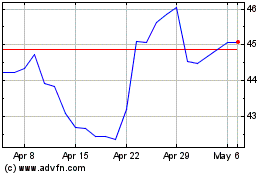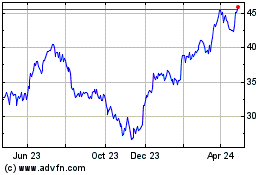By Mike Colias
Auto makers fresh off heady sales and profits in the first
quarter are preparing for a rough ride ahead, as the global
computer-chip shortage clouds an otherwise ripe environment for car
sales.
General Motors Co. on Wednesday reported a near-record operating
profit for the January-March period while rival Ford Motor Co. a
week earlier posted its best bottom line in years. Jeep-maker
Stellantis NV said sales rose 14% for the quarter and confirmed
earlier full-year guidance of 5.5% to 7.5% adjusted operating
margins. It reports half-year earnings results in August.
But each company said the shortage of semiconductors that has
forced production cuts across car factories world-wide since
January will pinch production and inventories even more heading
into the summer, just as American car buyers are turning out to
dealerships in droves.
That means car shoppers in the coming months are likely to find
slimmer options and fewer deals, from new and used dealerships to
the rental-car lot.
The auto industry's inventory crunch has produced a favorable
knock-on effect: record pricing. Dealers and car companies are
working with such thin inventory that they have been able to
withhold the generous discounts and promotions they normally dangle
to entice shoppers.
In the first quarter, the average financial incentive on new
vehicles fell 20% from a year earlier, while the average price paid
hit a quarterly record of $37,314, according to research firm J.D.
Power.
Meanwhile, the economic conditions for new-vehicle demand are
more favorable than they have been in years, analysts and
executives say, as pandemic restrictions loosen, federal stimulus
money flows and interest rates remain tame. The pace of new-vehicle
sales in April hit its fastest clip in more than 15 years on a
seasonally-adjusted basis, according to JPMorgan Chase.
But with the chip shortage worsening, car makers have been
cutting more factory work shifts. While auto executives see the
situation improving after June, for now, it is crimping inventory
even further and could dampen what was setting up to be a banner
summer at U.S. car dealerships.
Stellantis said the lack of semiconductors resulted in an 11%
reduction in planned first-quarter production, or about 190,000
vehicles, and that the problem will force it to cut second-quarter
production even more.
Ford said last week that it will lose half of its planned
second-quarter production because of strained chip supplies. Its
shares slid 9% the day after it laid out profit guidance for the
rest of 2021 that disappointed investors.
On Wednesday, Ford said it is adding at least two more weeks of
down time or limited output at several factories that had been shut
for weeks, including its Explorer SUV plant in Chicago and a Kansas
City, Mo., factory where it makes F-150s and Transit vans. Ford
also is idling its Ranger pickup plant near Detroit for the second
half of May, a spokeswoman said.
GM wouldn't quantify its production cuts, but confirmed the chip
shortage will hurt more in the second quarter.
Still, it seems clear that it is hurting Ford worse. Ford pegged
the fallout for the year at about $2.5 billion, while GM estimated
its impact at $1.5 billion to $2 billion.
The semiconductor shortage has forced Ford to reduce output for
several weeks at its two plants that assemble the F-150 pickup
truck, the company's bestseller and its biggest moneymaker.
Meanwhile, GM's key pickup-truck and big-SUV factories have
managed to sustain near-normal schedules.
RBC analyst Joseph Spak said investors were spooked by Ford's
dimmer outlook and had been waiting to see if GM would cut its
profit forecast because of the semiconductor situation.
"Bottom line, GM looks to be managing through better," he said
in a note.
Tens of thousands of factory workers have been put on layoff for
weeks or even a month or two as the auto makers have canceled work
shifts. The companies pay them reduced wages under terms of their
contracts with the United Auto Workers.
GM Chief Executive Mary Barra said she is confident that GM can
hit the high range of its original 2021 pretax profit forecast of
$10 billion to $11 billion. Ford's guidance is for $5.5 billion to
$6.5 billion.
Shares of GM rose 3.5% in afternoon trading Wednesday and were
up 33% this year through Tuesday. Ford's stock rose 1.2% Wednesday
and was up 30% this year through Tuesday.
GM credited its $4.4 billion pretax first-quarter profit in part
to brisk sales of its redesigned large SUVs, including the
Chevrolet Suburban and Cadillac Escalade, which have routinely sold
for more than $100,000 since refreshed models arrived last
year.
Ms. Barra said the semiconductor situation is "complex and
fluid" and will cause more trouble in the second quarter, but
should subside through the second half of the year.
Ms. Barra also said the disruption won't affect the company's
plan to spend bigger this year on developing electric and
autonomous vehicles, future bets that today are money losers but
have sparked investor enthusiasm. GM has said the majority of its
roughly $10 billion in capital expenditures this year will go
toward those potential growth areas.
"We continue to manage the transformation while managing, I'll
say, the tactical challenges of the semiconductors that we will
move out of," Ms. Barra told reporters during a conference
call.
GM also cited strong results from its lending arm, GM Financial,
which is benefiting from surging resale values for the used cars it
keeps on its books. The lender posted a record first-quarter pretax
profit of about $1.2 billion.
Nick Kostov and Nora Naughton contributed to this article.
Write to Mike Colias at Mike.Colias@wsj.com
(END) Dow Jones Newswires
May 05, 2021 16:08 ET (20:08 GMT)
Copyright (c) 2021 Dow Jones & Company, Inc.
General Motors (NYSE:GM)
Historical Stock Chart
From Mar 2024 to Apr 2024

General Motors (NYSE:GM)
Historical Stock Chart
From Apr 2023 to Apr 2024
